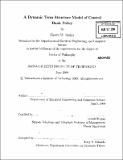A dynamic term structure model of Central Bank policy
Author(s)
Staker, Shawn W
DownloadFull printable version (7.853Mb)
Other Contributors
Massachusetts Institute of Technology. Dept. of Electrical Engineering and Computer Science.
Advisor
Leonid Kogan.
Terms of use
Metadata
Show full item recordAbstract
This thesis investigates the implications of explicitly modeling the monetary policy of the Central Bank within a Dynamic Term Structure Model (DTSM). We follow Piazzesi (2005) and implement monetary policy by including the Fed target rate as a state variable. The discontinuous target dynamics are accurately modeled via a non-linear switching process, while still maintaining affine requirements under the pricing measure ensuring tractability. To ensure a flexible risk specification we turn to the parametrization of Cheridito et al (2007), with extensions to the target jump process. Model parameters are estimated via a simulated maximum likelihood estimation scheme with importance sampling. A Bayesian particle filter is used as a robustness check, and it's use for static parameter estimation in a DTSM framework is explored. Our results support those in Piazzesi (2005), revealing a substantial improvement in pricing errors especially on the short end of the yield curve. The model construction provides a natural framework to inspect monetary policy information embedded in yields, which is found to be substantial. We find the addition of the target rate greatly improves the model's ability to explain excess return. An ability which is increased with the inclusion of the full term structure of target rates, as measured from Fed future contracts. We postulate the improved performance is due to the target as a proxy for short term rates, and a conduit to express the information content of the term structure of target rates.
Description
Thesis (Ph. D.)--Massachusetts Institute of Technology, Dept. of Electrical Engineering and Computer Science, 2009. Cataloged from PDF version of thesis. Includes bibliographical references (p. 115-118).
Date issued
2009Department
Massachusetts Institute of Technology. Department of Electrical Engineering and Computer SciencePublisher
Massachusetts Institute of Technology
Keywords
Electrical Engineering and Computer Science.